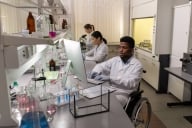You have /5 articles left.
Sign up for a free account or log in.
As an expert on sexual harassment, I have been surprised how little academics discuss navigating harassment and sexual violence when research takes us abroad. Unfortunately, neither federal laws and regulations nor the efforts of universities, research institutes and professional associations have been able to eradicate harassment and sexual violence. In the field or in research institutions abroad, women might simply end up having to navigate harassment and sexual violence by themselves. Thus, parallel to the work on improving institutions, I argue that we need to share individual strategies that empower women and other people who are vulnerable to such violations.
International research and collaborations can expand academics’ horizons and provide personal and professional enrichment and growth. They offer important intellectual challenges, as well as opportunities to collect crucial data to advance research over all. In some disciplines, conducting research abroad is necessary part of the research process, as global phenomena like oceans, climate change, epidemics and geographical rock formations transcend national boundaries. Studying other countries or specific local and linguistic communities also requires international travel at times.
But often when academic work takes researchers abroad, women professors encounter what I call gendered “glass fences.” Like the glass ceilings faced by women managers who climb the hierarchical ladder in work organizations, glass fences are invisible barriers embedded in the gendered organization and culture of academe, although they demarcate national borders. Sexual harassment is one such fence, because it can function to keep women in their home territories, denying them opportunities associated with international research. The particular forms and experiences vary depending across academic rank and position, gender identity, sexual orientation, race, ethnicity, age, disability, and other (visible) markers of difference. For example, the safety of openness about queerness certainly varies a lot across national contexts and even particular neighborhoods.
A typical scenario that could set up an uncomfortable situation leading to sexual harassment is when you are asked out for a drink by a key contact in the field or colleague in an international research institute. What do you say? Another typical situation is that, while conducting research abroad, you might struggle not only with harassment walking down the street but also while in the field or in research institutes.
Of course, sexual harassment can, and does, happen at home, so some of the suggestions I offer are translatable to domestic settings. But navigating an unfamiliar environment can amplify the challenges of strategizing to avoid harassment. Different local, linguistic, gender, academic and legal cultures create such challenges.
For example, feeling dependent on a key local contact or colleague for your research might limit your sense of options. And the (hierarchical) power relations become more diffuse the more time teams spend together during work and after hours without other friends or family around. Socializing centered on alcohol is notorious for creating “unusual” situations in which perpetrators overstep professional boundaries by pretending that what they do after work and when inebriated is an exception -- something out of the ordinary but, since no one is watching, it’s just for fun, not really serious. For victims, however, the harassment means violating their personal boundaries and dignity. And the violence threatens their autonomy and sexual self-determination.
Preparing to Venture Abroad
Do not misunderstand me: I am not discouraging international research. Still, I argue that academic institutions should take the lead in better preparing academics for the realities of harassment and sexual violence. Of course, American higher education institutions do carry the legal responsibility for any forms of harassment that professors and other research team members might engage in. But merely informing academics about their rights and responsibilities -- namely, the common practice of encouraging reporting sexual violence when it happens -- is simply not enough.
Thus, predeparture workshops that universities organize should follow feminist self-defense and self-assertiveness principles. Those include developing safety plans, role-playing and thinking through what-if scenarios in order to come up with concrete, context-specific strategies, so people can consider multiple ways to respond should harassment or violence occur. Learning about and sharing strategies can be empowering.
In my book Women in Global Science, I have collected examples of different strategies that faculty members use. Women, for example, set up meetings with local contacts exclusively in office spaces or in public areas, including hotel lobbies or coffee shops. Others try to arrange meetings over lunch or coffee instead of dinner or drinks. Private locations, such as hotel rooms, are considered off-limits for professional meetings.
Women faculty members purposefully bring their graduate students and postdoctoral fellows or even spouses/partners to international research sites. That allows them to engage in after-hours socializing events while avoiding uncomfortable one-on-one situations and unprofessional encounters. Dining with a small group of colleagues changes the social context. And that way, they will not miss out on these important informal encounters that are so crucial for their careers, because networking, advice, building rapport and trust take place once the “official” work is completed.
Other women have reported following general advice offered for women traveling by themselves, including wearing wedding rings or inviting male friends or their partners to spend time with them visibly in the field to create an image of a woman who is already taken. Women repeatedly stressed paying attention and trusting their instincts. If the situation feels weird, it most likely is.
The U.S. Department of State, the United Nations and international NGOs also provide valuable resources with relevant safety postings and protocols. In case of an occurrence of sexual violence, knowledge of the police and/or criminal justice systems and how they handle sexual violence is crucial. For example, in some countries, reporting a sexual assault or rape abroad might mean that the “witness” cannot leave the country until the closing of the case. And, depending on the context, the police and criminal justice system might consider the victim the problem, after all. Thus, having the contact information of the embassy and a university back home to tap into legal expertise can be important.
Finally, I recommend familiarizing yourself with the country, city, town or local environment and reading up on cultural nuances, local customs and social norms. That will help you to decide whether you want to adapt to or resist the gendered norms or dress codes you see locals using. I also highly recommend seeking out other scholars who have had experiences in a particular country, city, town, neighborhood and/or research setting to learn more about the particular environment. That can also help you identify potential local allies.
As a researcher, I know that such precautions will not entirely protect you. And as a feminist, I am not saying that someone is to blame for the violence and harassment they encounter if they do not follow such precautions. But I recognize that, in reality, having the information and resources to decide where to stay, eat and so on can significantly contribute to actual and perceived safety.
Thus, since institutions have not stopped perpetrators, academic institutions should at least provide resources to learn about, prepare and develop strategies for combating harassment and violence for faculty members who participate in international research endeavors. Professional associations, too, should mobilize to raise issues of sexual harassment in their ethical practices, as exemplified most recently by the women in the American Geophysical Union, and create spaces at meetings and online to share effective ways to deal with the issues. Ultimately, the fact is that glass fences continue to re-create global gender inequalities for women scholars -- thus, effective efforts to dismantle those fences will contribute to creating a more inclusive global academic world.




